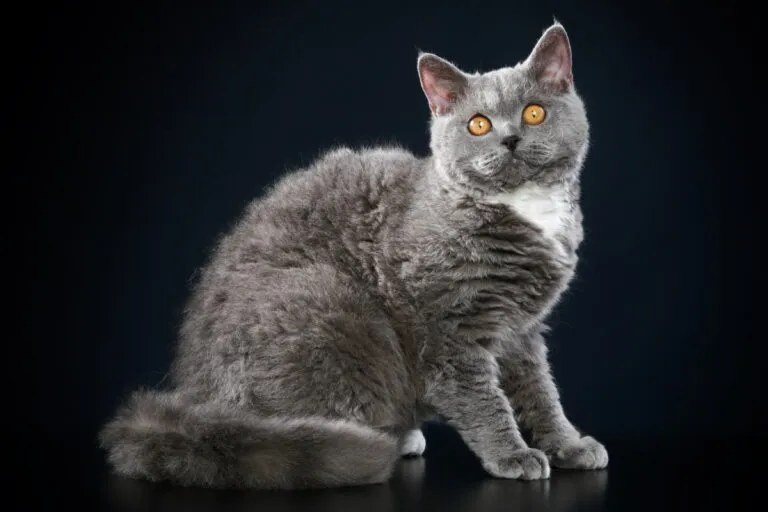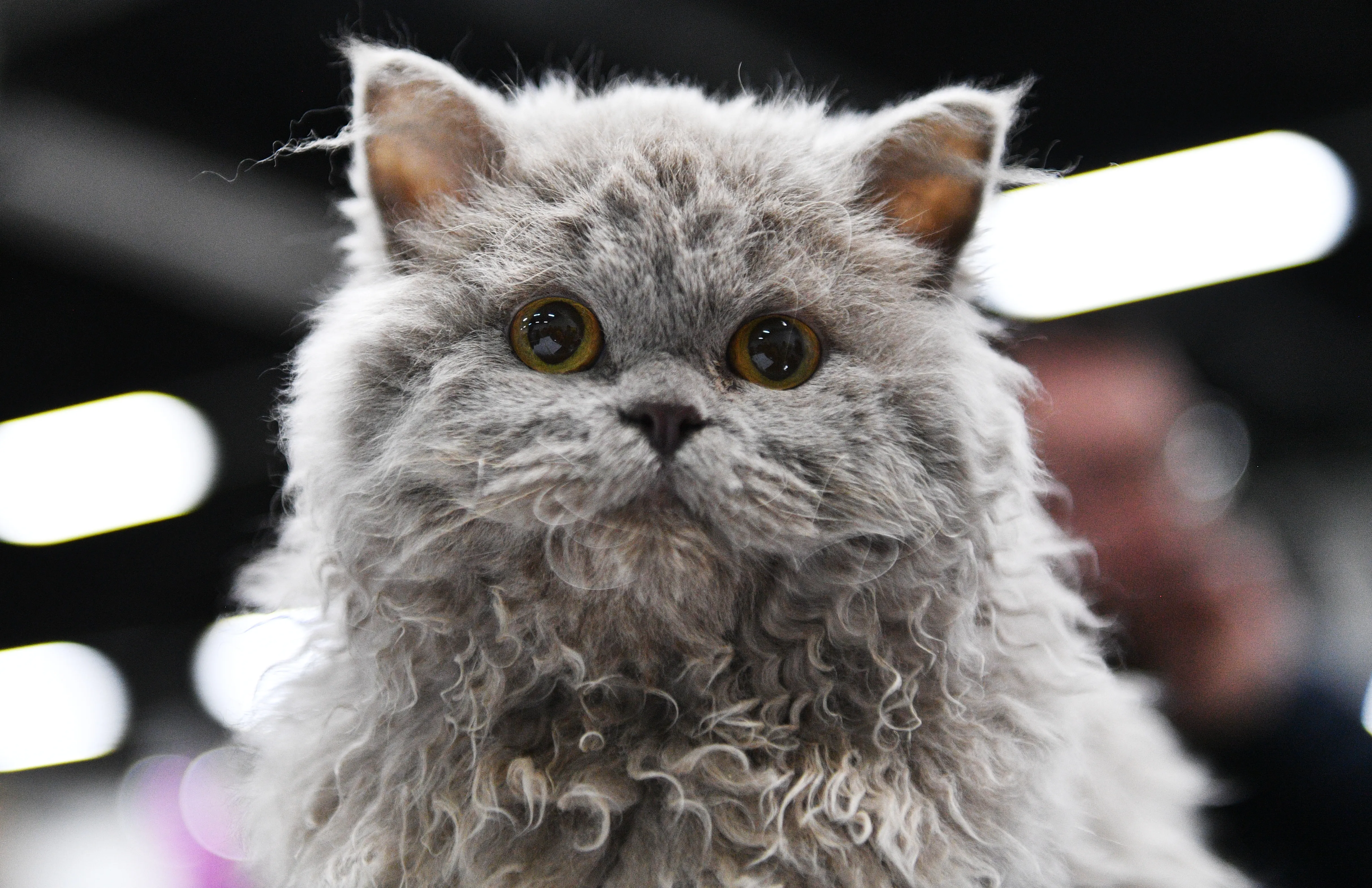Maine Coon
The Maine Coon has become one of the most popular cat breeds in the world. This is probably due to its majestic appearance, robust nature and great character.
The Selkirk Rex is one of the few cat breeds with curly hair. Its unusual look and gentle character has led to it conquering the hearts of cat lovers.

© jagodka / stock.adobe.com
The origins of the Selkirk Rex can be traced back to an animal shelter in the US, where a litter of kittens was handed in in 1987. However, one of the kittens was so different from its five siblings that the keepers were astonished: it had curly fur – including wavy whiskers – and bright green eyes. This was a spontaneous mutation of the fur. The employees at the animal shelter let the Persian breeder Jeri Newman know about the unusual kitten. Newman took it in and named it Miss Depesto of Noface. When Miss Depesto reached adult age, Newman crossed her with a black Persian male and was soon rewarded with six little kittens: three had smooth fur and the other three wavy fur. Newman named the new breed the Selkirk Rex.
In the following decades, the Selkirk Rex developed slowly but purposefully. To this day, controlled out-crossings with other breeds like the British Shorthair or Persian are permitted in some associations. The curls are inherited as an autosomal dominant trait, meaning that heterozygous cats have curls. However, if you cross two heterozygous Selkirk Rexes, this can result in kittens without the curly-haired gene. Only when one parent is a homozygous carrier of the curly-haired gene do all kittens end up having curls.
There are other cats with curly fur along with the Selkirk Rex, although this is traced back to other genetic mutations. These include the German Rex, Devon Rex and Cornish Rex, as well as the new LaPerm breed. Incidentally, the name “Rex” originates from rabbit breeding, in which rabbits with similar fur were called “Rex rabbits”. Breeding Rex cats is partly viewed critically if the whiskers are curly and thereby shorter. Some animal-rights activists criticise the fact that the function of the whiskers is limited.
The most striking feature of these felines is their curly fur, which can be both long and short, though it doesn’t have to be, since smooth-haired offspring can result from crossing Selkirk Rexes with each other too. However, smooth-haired cats do have all the same other physical features as their curly-haired siblings. Weighing a maximum of 7kg, the breed is medium-sized to large with a strong bone structure, making it the biggest of the curly-haired cats. It has a strong head with broad cheeks and round eyes that are relatively far apart. The brow can be seen very prominently from the side. The fur can be long or short, whilst all colours including patterns like tabby or point are allowed.
As long as it comes from a responsible breeder, the Selkirk Rex is affectionate and friendly. It loves the company of its family and insists upon cuddling sessions. It has been lovingly called the “canine cat” due to its tendency to follow its owners wherever they go. They generally get on fantastically with fellow cats and should only be kept together with a second cat. If they have already been accustomed to a lot of things since they were kittens, they easily adapt to their human family and don’t fear vacuum cleaners or car journeys.
Selkirk Rexes need a diet containing plenty of meat. A balanced wet food with a high meat content is ideally suited to providing all the nutrients it needs. Good cat food should contain neither grain nor sugar. If you want to treat your feline, give it healthy snacks like freeze-dried meat chunks. It can be tasty and fun for cats if you give them some dry food to discover for themselves each day: for instance, in the form of search games or with an intelligence toy for cats. However, it’s important that you bear in mind the energy content with respect to the overall daily intake. Weigh adult Selkirk Rexes every few weeks to notice any potential weight gain and react in good time should your cat get too fat. Fresh drinking water should always be readily available – drinking fountains can motivate cats to drink more often.
 © Sel_Sanders / stock.adobe.com
© Sel_Sanders / stock.adobe.com
The Selkirk Rex is considered a healthy breed – if it comes from a responsible breeder. A scrupulous breeder will definitely test in advance animals that will potentially be used for breeding for PKD (polycystic kidney disease). This is a kidney disease that regularly affects Persians and British Shorthairs, therefore the Selkirk Rex is similarly at risk. Stick to appointments for ongoing vaccinations and discuss any required deworming with your vet. A Selkirk Rex can reach 15 years of age or more.
Grooming the Selkirk Rex’s soft fur is generally straightforward, both for the short and long-haired variety. Thoroughly brush the fur at least once a week. This may be necessary more frequently during the moulting period. If they are used to this as a kitten, they will learn to enjoy it as a part of their routine. On a side note, it can take until adult age for your Selkirk Rex to have a typical curly coat. Growing kittens are often affected by hair loss, although this is mostly no cause for concern. If in doubt, discuss this with your breeder, who will presumably be familiar with this transition period from their experience with the parent animals.
Regularly check your feline friend’s ears too – dirt or potential inflammation is often more difficult to recognise with very furry ears. Particularly with older cats, you should frequently examine the claws, because they don’t wear them down regularly. Claws that are too long can get caught painfully or even grow into the paw pads. Trim them in advance with clippers in order to avoid injuries.
A Selkirk Rex is a good fit for you if you can offer it feline company and an environment appropriate for cats, so that it won’t matter if you’re out of the house for several hours a day. A balcony secured by a cat net is ideal or even a cat-proof garden that your feline can explore free of danger. If you have children, make sure that your Selkirk Rex always has a place to retreat to, such as a cat tunnel, if things get too much for it, because many cats of this breed like a calm environment. Teach small children to handle pets with respect.
Before taking on a pair of kittens, consider who will look after them when you go on holiday. A neighbour who can visit at least twice a day to give them cuddles and food is a good option. If you wish to hand over your cats to a cattery or acquaintances, it’s recommended to practise this in advance – for instance, over a weekend. Above all pairs of cats that have been used to it from a young age usually have no problem with this and you can go away with peace of mind.
Some cats are described as “allergy-friendly”, including the Selkirk Rex. Indeed, some people who are allergic to other cats don’t react to the Selkirk Rex, although this is not the case for every cat lover. Before taking on a pair of cats, play it safe and discuss your intentions beforehand with your doctor. In collaboration with the breeder in question, you can arrange a visit lasting several hours and provide your doctor with hair samples in order to establish before a decision is made if you do suffer from an allergic reaction to your dream cat.
You can make advance preparations by ensuring that your Selkirk Rex has everything it needs. This includes a scratching post in an accessible spot, numerous bowls and possibly a drinking fountain, cosy blankets or a basket, a carry case and a litter box for each cat. Toys and a litter scoop are essential, as well as a brush for grooming. You should always have a high-quality food and an absorbent cat litter in stock too. Take a look at the ongoing costs, as well as upfront costs, before making a decision on your new pet. In addition, there are veterinary costs for regular check-ups, which can increase rapidly in case of illness.
Don’t look at dodgy classified ads offering “cats for allergy sufferers” at a cheap price – contact a responsible breeder instead. Although they sometimes use classified ads too, they carefully select the future owners. After all, this concerns their wellbeing and not just a quick buck. A breeder shouldn’t give kittens away before the age of 12 weeks – ideally only after 16 weeks. They will then be house-trained, vaccinated on several occasions, thoroughly dewormed and arrive microchipped and with their vaccination card in order.
Tip: If you don’t mind a slightly older cat, look in animal shelters too. Here you will occasionally find curly-haired beauties looking for a new home. Some animal protection organisations focus on pedigree cats in need – look here if you don’t strike lucky in local animal shelters.
We wish you a wonderful time with your curly-haired beauty!
The Maine Coon has become one of the most popular cat breeds in the world. This is probably due to its majestic appearance, robust nature and great character.
Large eyes and attentively upright ears instantly tell you a great deal about this charming breed of cat: Abyssinians are inquisitive and affectionate towards people.
With its long, dense fur, rounded ears, and intense stare, the Pallas Cat, or Manul, looks rather fluffy, yet somewhat dangerous. However, don't be fooled by its appearance—this is no petting zoo resident. The Manul is a wild animal and considered untameable.